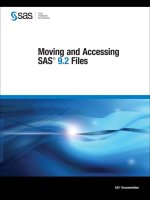Wiley digital signal processing techniques and applications in radar image processing aug 2008 ISBN 0470180927 pdf
Bạn đang xem bản rút gọn của tài liệu. Xem và tải ngay bản đầy đủ của tài liệu tại đây (1.94 MB, 368 trang )
DIGITAL SIGNAL
PROCESSING
TECHNIQUES AND
APPLICATIONS IN RADAR
IMAGE PROCESSING
Bu-Chin Wang
A JOHN WILEY & SONS, INC., PUBLICATION
DIGITAL SIGNAL
PROCESSING
TECHNIQUES AND
APPLICATIONS IN RADAR
IMAGE PROCESSING
WILEY SERIES ON INFORMATION AND COMMUNICATIONS TECHNOLOGIES
Series Editors: Russell Hsing and Vincent K. N. Lau
The Information and Communications Technologies (ICT) book series focuses on creating
useful connections between advanced communication theories, practical designs, and enduser applications in various next generation networks and broadband access systems, including fiber, cable, satellite, and wireless. The ICT book series examines the difficulties of
applying various advanced communication technologies to practical systems such as WiFi,
WiMax, B3G, etc., and considers how technologies are designed in conjunction with standards, theories, and applications.
The ICT book series also addresses application-oriented topics such as service management and creation and end-user devices, as well as the coupling between end devices and
infrastructure.
T. Russell Hsing, PhD, is the Executive Director of Emerging Technologies and Services
Research at Telcordia Technologies. He manages and leads the applied research and development of information and wireless sensor networking solutions for numerous applications
and systems. Email:
Vincent K.N. Lau, PhD, is Associate Professor in the Department of Electrical Engineering
at the Hong Kong University of Science and Technology. His current research interest is on
delay-sensitive cross-layer optimization with imperfect system state information. Email:
Wireless Internet and Mobile Computing: Interoperability and Performance
Yu-Kwong Ricky Kwok and Vincent K. N. Lau
RF Circuit Design
Richard C. Li
Digital Signal Processing Techniques and Applications in Radar Image Processing
Bu-Chin Wang
DIGITAL SIGNAL
PROCESSING
TECHNIQUES AND
APPLICATIONS IN RADAR
IMAGE PROCESSING
Bu-Chin Wang
A JOHN WILEY & SONS, INC., PUBLICATION
Copyright
C
2008 by John Wiley & Sons, Inc. All rights reserved.
Published by John Wiley & Sons, Inc., Hoboken, New Jersey
Published simultaneously in Canada
No part of this publication may be reproduced, stored in a retrieval system, or transmitted in any form or
by any means, electronic, mechanical, photocopying, recording, scanning, or otherwise, except as
permitted under Section 107 or 108 of the 1976 United States Copyright Act, without either the prior
written permission of the Publisher, or authorization through payment of the appropriate per-copy fee to
the Copyright Clearance Center, Inc., 222 Rosewood Drive, Danvers, MA 01923, (978) 750-8400,
fax (978) 750-4470, or on the web at www.copyright.com. Requests to the Publisher for permission
should be addressed to the Permissions Department, John Wiley & Sons, Inc., 111 River Street, Hoboken,
NJ 07030, (201) 748-6011, fax (201) 748-6008, or online at />Limit of Liability/Disclaimer of Warranty: While the publisher and author have used their best efforts in
preparing this book, they make no representations or warranties with respect to the accuracy or
completeness of the contents of this book and specifically disclaim any implied warranties of
merchantability or fitness for a particular purpose. No warranty may be created or extended by sales
representatives or written sales materials. The advice and strategies contained herein may not be suitable
for your situation. You should consult with a professional where appropriate. Neither the publisher nor
author shall be liable for any loss of profit or any other commercial damages, including but not limited to
special, incidental, consequential, or other damages.
For general information on our other products and services or for technical support, please contact our
Customer Care Department within the United States at (800) 762-2974, outside the United States at
(317) 572-3993 or fax (317) 572-4002.
Wiley also publishes its books in a variety of electronic formats. Some content that appears in print may
not be available in electronic formats. For more information about Wiley products, visit our web site at
www.wiley.com.
Library of Congress Cataloging-in-Publication Data
Wang, Bu-Chin.
Digital signal processing techniques and applications in radar image processing / Bu-Chin Wang.
p. cm.
ISBN 978-0-470-18092-1
1. Signal processing—Digital techniques. 2. Remote sensing. I. Title.
TK5102.9.W36 2008
621.36 78–dc22
2008004941
Printed in the United States of America
10 9 8 7 6 5 4 3 2 1
To my mother Chun-Ying Wang,
in memory of my father Lan-Din Wang, and
to my wife Rhoda and our children,
Anna and David
CONTENTS
Preface
xiii
List of Symbols
xvii
List of Illustrations
xxi
1
Signal Theory and Analysis
1
1.1 Special Functions Used in Signal Processing / 1
1.1.1 Delta or Impulse Function ␦(t) / 1
1.1.2 Sampling or Interpolation Function sinc (t) / 2
1.2 Linear System and Convolution / 3
1.2.1 Key Properties of Convolution / 5
1.2.1.1 Commutative / 5
1.2.1.2 Associative / 5
1.2.1.3 Distributive / 5
1.2.1.4 Timeshift / 5
1.3 Fourier Series Representation of Periodic Signals / 6
1.3.1 Trigonometric Fourier Series / 6
1.3.2 Compact Trigonometric Fourier Series / 6
1.3.3 Exponential Fourier Series / 7
1.4 Nonperiodic Signal Representation by Fourier Transform / 11
1.5 Fourier Transform of a Periodic Signal / 16
1.6 Sampling Theory and Interpolation / 19
1.7 Advanced Sampling Techniques / 24
1.7.1 Sampling with Bandpass Signal / 24
1.7.2 Resampling by Evenly Spaced Decimation / 25
1.7.3 Resampling by Evenly Spaced Interpolation / 25
1.7.4 Resampling by Fractional Rate Interpolation / 26
vii
viii
CONTENTS
1.7.5 Resampling from Unevenly Spaced Data / 28
1.7.5.1 Jacobian of Transformation / 28
2 Discrete Time and Frequency Transformation
35
2.1 Continuous and Discrete Fourier Transform / 35
2.2 Key Properties of Discrete Fourier Transform / 38
2.2.1 Shifting and Symmetry / 39
2.2.2 Linear and Circular Convolution / 39
2.2.3 Sectioned Convolution / 41
2.2.3.1 Overlap-and-Add Method / 42
2.2.3.2 Overlap-and-Save Method / 42
2.2.4 Zero Stuffing and Discrete Fourier Transform (DFT)
Resolution / 43
2.3 Widows and Discrete Fourier Transform / 48
2.4 Fast Fourier Transform / 50
2.4.1 Radix-2 Fast Fourier Transform (FFT) Algorithms / 50
2.5 Discrete Cosine Transform (DCT) / 53
2.5.1 Two-Dimensional DCT / 57
2.6 Continuous and Discrete Signals in Time and Frequency Domains / 57
2.6.1 Graphical Representation of DFT / 57
2.6.2 Resampling with Fractional Interpolation Based on DFT / 60
3 Basics of Antenna Theory
3.1 Maxwell and Wave Equations / 63
3.1.1 Harmonic Time Dependence / 65
3.2 Radiation from an Infinitesimal Current Dipole / 67
3.2.1 Magnetic Vector Potential Due to a Small but Finite Current
Element / 68
3.2.2 Field Vectors Due to Small but Finite Current Radiation / 69
3.2.3 Far-Field Region / 70
3.2.4 Summary of Radiation Fields / 72
3.3 Radiation from a Half-Wavelength Dipole / 73
3.4 Radiation from a Linear Array / 74
3.4.1 Power Radiation Pattern from a Linear Array / 78
3.5 Power Radiation Pattern from a 2D Rectangular Array / 80
63
CONTENTS
ix
3.6 Fundamentals of Antenna Parameters / 81
3.6.1 Radiation Beamwidth / 81
3.6.2 Solid Angle, Power Density, and Radiation Intensity / 82
3.6.3 Directivity and Gain / 84
3.6.4 Antenna Impedance / 84
3.6.5 Antenna Efficiency / 85
3.6.6 Effective Area and Antenna Gain / 85
3.6.7 Polarization / 89
3.7 Commonly Used Antenna Geometries / 89
3.7.1 Single-Element Radiators / 89
3.7.2 Microstrip Antennas and Antenna Array / 91
4
Fundamentals of Radar
93
4.1 Principles of Radar Operation / 93
4.2 Basic Configuration of Radar / 96
4.2.1 Waveform Generator / 96
4.2.2 Transmitter / 96
4.2.3 Antenna System / 96
4.2.4 Receiver / 97
4.2.5 Computer/Signal Processor / 97
4.2.6 Timing and Control / 97
4.3 The Radar Range Equation / 97
4.4 Cross Section and Clutter / 100
4.4.1 Target Cross Section / 100
4.4.2 Cross Section and the Equivalent Sphere / 101
4.4.3 Cross Section of Real Targets / 101
4.4.4 Radar Cross Section (RCS) / 101
4.4.5 Clutter / 102
4.5 Doppler Effect and Frequency Shift / 103
4.5.1 Doppler Frequency / 104
4.6 Radar Resolution and Ambiguity Function / 110
5
Radar Modulation and Target Detection Techniques
5.1 Amplitude Modulation (AM) Radar / 116
5.1.1 Continuous-Wave (CW) Radar / 117
5.1.2 Pulse Modulation Radar / 117
116
x
CONTENTS
5.2 Target Detection Techniques of AM-Based Radar / 119
5.2.1 Doppler Frequency Extraction / 119
5.2.2 Motion Direction Detection / 121
5.3 Frequency Modulation (FM)-Radar / 123
5.3.1 Pulsed Linear Frequency Modulation (LFM) Radar / 124
5.3.2 Continuous-Wave Linear Frequency Modulation Radar / 129
5.3.3 Stepped Frequency Modulation Radar / 130
5.4 Target Detection Techniques of FM-Based Radar / 133
5.4.1 In-Phase Quadrature-Phase Demodulator / 133
5.4.2 Matched Filter and Pulse Compression / 134
5.4.3 Target Detection Techniques of LFM Radar / 141
5.4.4 Target Detection Techniques of SFM Radar / 149
6 Basics of Radar Imaging
155
6.1 Background / 155
6.2 Geometry of Imaging Radar / 157
6.3 Doppler Frequency and Radar Image Processing / 159
6.3.1 Broadside SAR / 161
6.3.2 SAR with Squint Angle / 174
6.3.2.1 SAR with a Small Squint Angle / 176
6.3.2.2 SAR with a Low Squint Angle / 180
6.4 Range Migration and Curvature / 185
6.5 Geometric Distortions of the Radar Image / 188
6.5.1 Layover / 188
6.5.2 Foreshortening / 189
6.5.3 Shadowing / 189
6.5.4 Slant-to-Ground Range Distortion / 189
6.5.5 Speckle / 189
6.6 Radar Image Resolution / 189
6.6.1 Example of Real Aperture Radar (RAR) Resolution:
ERS-1/2-Imaging Radars / 191
7
System Model and Data Acquisition of SAR Image
7.1 System Model of Range Radar Imaging / 194
7.1.1 System Model / 194
7.1.2 Reconstruction of Range Target Function / 196
194
xi
CONTENTS
7.2 System Model of Cross-Range Radar Imaging / 199
7.2.1 Broadside Radar Case / 199
7.2.1.1 System Model / 199
7.2.1.2 Principle of Stationary Phase / 203
7.2.1.3 Spatial Fourier Transform of Cross-Range Target
Response / 207
7.2.1.4 Reconstruction of Cross-Range Target Function / 210
7.2.2 Squint Radar Case / 213
7.2.2.1 System Model / 213
7.2.2.2 Spatial Fourier Transform of Cross-Range Target
Response / 216
7.2.2.3 Reconstruction of Cross-Range Target Function / 219
7.3 Data Acquisition, Sampling, and Power Spectrum of Radar
Image / 221
7.3.1 Digitized Doppler Frequency Power Spectrum / 223
7.3.1.1 Broadside SAR / 223
7.3.1.2 Squint SAR / 223
8
Range–Doppler Processing on SAR Images
8.1 SAR Image Data Generation / 227
8.2 Synthesis of a Broadside SAR Image Data Array / 231
8.2.1 Single-Target Case / 231
8.2.2 Multiple-Target Case / 235
8.3 Synthesis of a Squint SAR Image Data Array / 240
8.3.1 Single-Target Case / 240
8.3.2 Multiple-Target Case / 242
8.4 Range–Doppler Processing of SAR Data / 246
8.4.1 Range Compression / 248
8.4.2 Corner Turn / 249
8.4.3 Range Cell Migration Correction / 249
8.4.3.1 Computation of Range Migration Amount / 249
8.4.3.2 Fractional Range Sample Interpolation / 252
8.4.3.3 Range Sample Shift / 252
8.4.4 Azimuth Compression / 254
8.4.4.1 Doppler Frequency Centroid / 254
8.4.4.2 Doppler Frequency Change Rate  / 254
8.4.4.3 Pulse Duration Time Ta / 254
226
xii
CONTENTS
8.5 Simulation Results / 255
8.5.1 Broadside SAR with Single Target / 255
8.5.2 Broadside SAR with Multiple Targets / 261
8.5.3 Squint SAR with Single Target / 267
8.5.4 Squint SAR with Multiple Targets / 275
9
Stolt Interpolation Processing on SAR Images
285
9.1 Wavenumber Domain Processing of SAR Data / 285
9.2 Direct Interpolation from Unevenly Spaced Samples / 288
9.3 Stolt Interpolation Processing of SAR Data / 290
9.3.1 System Model of Broadside SAR with Six Targets / 294
9.3.2 Synthesis of Broadside SAR Data Array / 296
9.3.3 Simulation Results / 298
9.3.4 System Model of Squint SAR with Six Targets / 305
9.3.5 Synthesis of Squint SAR Data Array / 307
9.3.6 Simulation Results / 309
9.4 Reconstruction of Satellite Radar Image Data / 320
9.5 Comparison Between Range–Doppler and Stolt Interpolation on
SAR Data Processing / 328
Further Reading
333
Index
335
PREFACE
In the past few decades, the principles and techniques of digital signal processing
(DSP) have been used in applications such as data and wireless communication,
voice and speech analysis and synthesis, and video and image compression and expansion. Radar image processing is considered the primary application of the remote
sensing field and is a new and emerging area for DSP applications. Although the
primary application of satellite-based radar imaging is military surveillance, the low
cost and real-time processing capability of radar imaging, together with its capability
to operate under any environmental conditions (e.g., night or day, rain or snow, fog
or clear sky) have opened up many commercial applications. Sea ice monitoring and
disaster monitoring of events such as forest fires, floods, volcano eruptions, earthquakes, and oil spills are examples of satellite-based radar imaging applications.
Airborne-based radar systems also have made radar imaging more affordable and
popular. Furthermore, exploration of underground natural resources is an example of
a new application.
The processing of radar images, in general, consists of three major fields: DSP
principles and communication theory, knowledge of antenna and radar operation, and
algorithms used to process the radar images. The purpose of this book is to include
the material in these fields in one publication, to provide the reader with a thorough
understanding of how radar images are processed. To further familiarize the reader
with the theories and techniques used in processing radar images, MATLAB* -based
programs are utilized extensively in this book in both the synthesis and analysis of
the radar image. In this way, the signal waveforms are therefore made visible at
various stages during computer simulation, and the capability of three-dimensional
(3D) graphical displays makes many abstract results easier to understand. This book
is aimed at engineers or students who have some knowledge of DSP theory and
limited knowledge of communication theory and/or antenna theory, but are interested
in advanced DSP applications, especially in the remote sensing field.
This book consists of three major groups of chapters. Chapters 1 and 2 provide an overview of DSP principles, reviewing signal characteristics in both analog
and digital domains and describing some DSP techniques that serve as key tools in
radar images processing. Chapters 3–5 discuss the basics of antenna theory, radar
* MATLAB
is a registered trademark of math Works, Inc., Natick, MA 01760.
xiii
xiv
PREFACE
operation principles, modulation/demodulation, and radar target detection techniques. Chapters 6–9 discuss the properties and formation of radar images and then
try to model the processing of radar images. The principles of radar image data synthesis are presented and demonstrated with computer-simulated examples. Both the
range–Doppler and the Stolt interpolation algorithms are described and applied to the
simulated image data and satellite radar-based image data. The results are analyzed
and compared. MATLAB∗ programs are used extensively during the generation of
various waveforms of signal processing, radar detection, and synthesis/simulation of
radar image processing.
The first two chapters briefly review the DSP principles. Chapter 1 describes the
characteristics of signals, followed by Fourier series representation of periodic signals. Fourier transform is then introduced to represent a signal, whether in periodic
or nonperiodic form. Sampling theory and interpolation filter are derived, and some
advanced sampling and interpolation techniques are reviewed. Resampling from unevenly spaced data to obtain evenly spaced data is briefly discussed at the end of the
chapter. Chapter 2 addresses the discrete signal transformation in both time and frequency domains. Discrete Fourier transform (DFT), together with some of its characteristics, are reviewed. Windowing functions and the well-known fast Fourier transform (FFT) technique are covered. The discrete cosine transform (DCT), which is
the byproduct of DFT, is introduced. A graphical representation of DFT provides an
overview of the relationship between a continuous signal and a discrete signal. It also
provides signal variations in both time and frequency domains. The chapter ends with
an example of resampling with fractional interpolation based on DFT technique.
Chapters 3–5 provide a background review on antenna theory and radar operation
principles. Chapter 3 starts the review of the electromagnetic field with the Maxwell
equation, followed by the electromagnetic (EM) fields generated from the infinitesimal dipole. Finite-length dipole- and half-wavelength dipole-based linear antenna arrays are described. Some commonly used antennas, including the microstrip antenna,
are also covered. Chapter 4 deals with the basic theory of radar signal processing. The
radar range equations and other related parameters are reviewed. The Doppler frequency due to relative movement between radar and target is briefly discussed with
respect to the wavefront. Some target range and motion direction detection techniques are also revealed at the end of chapter. Chapter 5 provides broad coverage
of modulation/demodulation and target detection techniques used by radar systems.
Amplitude modulation (AM)-based pulse Doppler frequency radar is first reviewed,
followed by discussion of target detection techniques. Frequency modulation (FM)based radars, which include pulsed linear FM (LFM), continuous-wave LFM and
stepped LFM signals, are then briefly discussed. Also covered in this chapter are
in-phase–quadrature-phase (I–Q) demodulator and pulse compression (or matched
filtering), which serve as important tools in radar signal processing
Chapters 6–9 discuss the main topic of this book: radar image formation and
processing. Chapter 6 starts with a survey of some popular imaging radars and possible applications, followed by the description of the geometry of stripmap synthetic
aperture radar (SAR), which consists of broadside SAR and squint SAR. The role of
Doppler frequency in radar image formation is analyzed. Also covered are the range
PREFACE
xv
migraion, geometric distortion, and resolution of image radar. Chapter 7 discusses
the ideal system model of radar imaging. The reconstruction of 2D target function is
modeled by two independent 1D functions. The model of 1D range imaging is first
described, followed by discussion of the 1D cross-range imaging. Data acquisition
and the frequency spectrum of radar image are also reviewed. Chapter 8 discusses
the principles of radar image generation and how to synthesize the radar image. Examples of synthesizing radar image data for broadside SAR and squint SAR are
presented, which include single and multiple targets. The range–Doppler algorithm
on processing radar images is then reviewed and applied to the synthesized data.
Chapter 9 reviews some radar image processing techniques in the wavenumber domain. The Stolt interpolation technique on radar image processing is briefly reviewed
and applied to some simulated image data. The real satellite radar signal is then processed by both range–Doppler and Stolt interpolation algorithms. A comparison on
these two algorithms is also provided.
Some of the material in this book was presented to graduate students in Su-Zhou
University in China, and the feedback from the students was incorporated into this
book. It is my hope that this book can provide enough knowledge for readers to
become familiar with radar image processing. Although I have made every effort
to make this a thorough and accurate book, errors and mistakes are inevitable. Any
comments or feedback from readers will be welcomed and appreciated.
Acknowledgment
I would like to thank Dr. Russell Hsing of Telcordia for his support and inspiration
throughout the process of writing this book. His advice made the publication of this
book possible and is greatly appreciated.
Finally, I owe a lot to my family for their patience and understanding as I worked
on this book. My wife, Rhoda, my children, Anna and David, my son-in-law, Scott
Chong, and granddaughter, Jocelyn, all helped make this book possible in numerous
ways, and I am grateful to them.
Bu-Chin Wang, PhD
LIST OF SYMBOLS
As
␣

B, Bt
B D , BDop
BDs
BDu
Bku
c
f
fb
f0
fc
fs
fm
f PRF
fD
f Dr
f Ds
f Du
f Dc
f Dcr
f Dcs
f Dcu
˙f Dcs
˙f Dc
˙f D
f DU
f DL
f DUr
f DLr
f DUs
Azimuth sample spacing along the azimuth or y axis, meters
Frequency change rate for LFM signal, hertz per second (Hz/s)
Frequency change rate for LFM signal along azimuth direction,
Hz/s
Frequency bandwidth, Hz
Doppler frequency bandwidth, Hz
Doppler frequency bandwidth in terms of slow time s, Hz
Doppler frequency bandwidth in terms of radar position u, Hz
Spatial frequency bandwidth in the ku domain, Hz
Speed of light, 3 × 108 meters per second (m/s)
Frequency, Hz
Baseband frequency, Hz
Reference frequency, Hz
Carrier frequency, Hz
Sampling frequency, Hz
Maximum frequency, Hz
Pulse repetition frequency, Hz
Doppler frequency, Hz
Doppler frequency in terms of slant range r , Hz
Doppler frequency in terms of slow time s, Hz
Doppler frequency in terms of radar position u, Hz
Centroid of Doppler frequency, Hz
f Dc with respect to slant range r , Hz
f Dc with respect to slow time s, Hz
f Dc with respect to radar position u, Hz
Derivative of f Dcs , or slope of f Dcs , Hz/s
Derivative of f Dc , or slope of f Dc , Hz/s
Derivative of f D , or slope of f D , Hz/s
Upper bound of Doppler frequency bandwidth, Hz
Lower bound of Doppler frequency bandwidth, Hz
f DU with respect to slant range r , Hz
f DL with respect to slant range r , Hz
f DU with respect to slow time s, Hz
xvii
xviii
LIST OF SYMBOLS
f DLs
f 0 (x)
f 0 (y)
f (x)
f (y)
F0 (k)
F0 (k y ), F0 (ku )
F(k)
F(k y ), F(ku )
h r (t)
h az (s)
h az (t,s)
Haz (, D )
Im (ku )
i m (u)
kx
ku
kum
ku
ky
k
kb
k0
kc
L
Ls
Lsa
Lsa2
Lsx
Lsx2
Lsai
Lsxi
L total
M
Mamb
N
Naz
Nazi
Nr
Nr x
p(t)
f DL with respect to slow time s, Hz
Ideal target function along range or x axis
Ideal target function along azimuth or y axis
Target function along range or x axis
Target function along azimuth or y axis
Fourier transform of f 0 (x)
Spatial Fourier transform of f 0 (y)
Fourrier transform of f (x)
Spatial Fourier transform of f (y)
Range matched filter
Azimuth matched filter
2D azimuth matched filter
2D spatiotemporal Fourier transform of h az (t,s)
Gating function in wavenumber ku domain due to mth target
Inverse spatial Fourier transform of Im (ku )
Spatial wavenumber, corresponding to spatial Fourier transform of
x, 1/meter (m−1 ; reciprocal meter)
Spatial wavenumber, corresponding to spatial Fourier transform of
u, m−1
Spatial wavenumber, corresponding to mth target
Spatial wavenumber changing rate
Same as ku , m−1
Wavenumber, corresponding to f , m−1
Wavenumber in baseband corresponding to f b , m−1
Wavenumber, corresponding to f 0 , m−1
Wavenumber, corresponding to f c , m−1
Wavelength of electromagnetic wave, m
Antenna length, m
Synthetic aperture length, m
Ls for target located at range R0a , m
Half size of Lsa, m
Ls for target located at range R0x for x = b, c, d . . . , m
Half size of Lsx, m
Lsa for ith target
Lsx for ith target
Sum of Lsx from all targets, m
Number of rows in a 2D data array
Doppler ambiguity
Number of columns in a 2D data array
Number of azimuth lines within the synthetic aperture length Ls
Number of azimuth lines within Ls for target located at range R0i
Number of samples within the transmitter pulse duration
Number of sample difference between range Rx , for x = b, c . . . ,
and range reference Ra
Transmitted radar signal
LIST OF SYMBOLS
P()
pb (t)
psf(t)
psf()
R0
R0a
R0i
Ru i n
Rc
R1
R3
Rs
RS
RL
R(s)
R(u)
⌬R
⌬ Rr
⌬ Rgr
⌬ Ra
s
sc
s(t)
sb (t)
S()
Sb ()
S(t,u)
S(, D )
sm (t,u)
Sm (, D )
sbm (t,u)
Sbm (, D )
sr0 (u)
Sr0 (ku )
u i
u i n
T, T0
Ta
xix
Fourier transform of p(t)
Baseband transmitted radar signal
Pont spread function in time domain
Fourier transform of psf(t)
Shortest distance between target and radar, m
R0 with target located at range x = a, m
R0 with target located at range x = b, c . . . , m
Slant range between target n and radar located at u i , m
Distance between target and radar when target is under
illunination of radar center beam, m
Distance between target and radar when radar starts to illuminate
the target, m
Distance between target and radar when radar stops to illuminate
the target, m
Slant range sample spacing, m
shortest distance from radar to ground along the range (x-axis)
direction, m
Longest distance from radar to ground along the range (x-axis)
direction, m
Slant range in terms of slow time s, m
Slant range in terms of radar position u, m
Slant range difference with respect to R0 (broadside SAR case) or
R3 (squint SAR case), m
Slant range resolution, m
Ground range resolution, m
Angular resolution, m
Slow time variable along radar moving direction, seconds (s)
Slow time when target is illuminated by center beam of radar, s
Target reflected signal
Baseband signal of s(t)
Fourier transform of s(t)
Fourier transform of sb (t)
Target reflected signal when radar is at location y = u
2D Spatiotemporal Fourier transform of s(t,u)
mth target reflected signal when radar is at location y = u
2D spatiotemporal transform of sm (t,u)
Baseband version of sm (t,u)
Baseband version of Sm (, D )
Range reference fouction for radar located at (0, u)
Spatial Fourier transform of sr0 (u)
Pulse duration time or echo delay time, s
Echo delay time when radar is located at u i , s
Echo delay time due to target n and when radar is located at u i , s
Period of periodic signal, s
Time duration when target is under illumination of radar beam, s
xx
LIST OF SYMBOLS
Tp
u
ui
u2
u1
u3
V
Vr
W
Xc
X0
Y0
Yc
yi
Ͻr nϾ
b
0
c
i
H
V
3dB
m (u)
u
q
␦(t)
sinc(t)
Rect(t)
| (, f D )|
F
F−1
J (u)
Pulse duration time, s
Radar position variable along the azimuth or y axis, m
Radar position at u = u i , m
Radar location when target is under illumination of radar center
beam, m
Radar location when radar begins to illuminate target, m
Radar location when radar ceases to illuminate target, m
Radar velocity, a vector along azimuth direction m/s
Radar’s radial velocity, a scalar along the target direction, m/s
Antenna width, m
Centerpoint of target area along x axis, m
Half size of target area along range (x-axis) direction, m
Half size of target area along azimuth (y-axis) direction, m
Centerpoint of target area along y axis, m
Target location along y axis, m
2D signal array corresponding to target n
Angular frequency, Hz
Angular baseband frequency, Hz
Angular reference frequency, Hz
Angular carrier frequency, Hz
Reflection coefficient from ith target
Angle, radians, or degrees
Horizontal beamwidth = /L, radians or degrees
Vertical beamwidth = /W , radians or degrees
Antenna 3-dB beamwidth, radians or degrees
Aspect angle with respect to mth target when radar is at location
y = u, radians or degrees
Equal to m (u) for single target
Radar squint angle, radians or degrees
Delta or impulse function
Sampling or interpolation filter function
Time-domain rectangular pulse with duration |t| ≤ 12
Radar ambiguity function
Fourier transform operator
Inverse Fourier transform operator
Jacobian of transformation
LIST OF ILLUSTRATIONS
Figures
1.1
1.2
1.3
1.4
1.5
1.6
1.7
1.8
1.9
1.10
1.11
1.12
1.13
1.14
1.15
1.16
1.17
1.18
1.19
1.20
1.21
2.1
2.2
2.3
2.4
2.5
A sinc (t) function.
A linear system.
Graphical representations of a function in terms of pulses.
A time-invariant linear system.
A periodic signal g p (t).
Fourier series coefficients of a periodic pulse.
A single pulse g(t) and its Fourier transform G().
A single-pulse frequency spectrum G() and its inverse Fourier
transform g(t).
A periodic impulse train and its Fourier transform.
Fourier transform of a periodic pulse train.
Graphical representations of the sampling theory.
Interpolation filters.
Original and half-sample-shifted digital signals.
Frequency spectra of a digitized bandpass signal.
Downsampling with a FIR filter.
Interpolation with zero insertion and FIR LPF.
Fractional rate interpolation with M = 2.5.
Interpolation on evenly spaced data.
Generation of unevenly spaced data index.
Relationship between evenly and unevenly spaced data.
Interpolation on unevenly spaced data.
A periodic sequence.
Linear convolution.
Circular convolution.
Linearized circular convolution.
Convolution using overlap-and-add method.
2
3
3
4
7
9
14
15
17
19
20
22
23
25
26
27
28
30
31
32
33
36
40
41
42
43
xxi
xxii
2.6
2.7
2.8
2.9
2.10
2.11
2.12
2.13
2.14
2.15
2.16
2.17
2.18
2.19
3.1
3.2
3.3
3.4
3.5
3.6
3.7
3.8
3.9
3.10
3.11
3.12
3.13
3.14
3.15
3.16
3.17
4.1
4.2
4.3
4.4
4.5
4.6
LIST OF ILLUSTRATIONS
Convolution using overlap-and-save method.
Hanning window with different sampling frequencies.
A 32-point Hanning window.
Hanning window with time-domain zero padding.
Hanning window with frequency-domain zero padding.
DFT with sliding (overlapping).
Hamming and Blackman window functions.
Three-stage computation of an 8-point DFT.
An 8-point FFT with decimation-in-time algorithm.
First stage of the decimation-in-frequency FFT algorithm.
The 8-piont decimation-in-frequency FFT algorithm.
Input block (a) and end effects in DFT (b) and DCT (c).
Graphical representations of DFT.
Example of resampling.
Potentials generated by current/charge distribution.
Radiation from a point radiator.
Far-field approximation of z-oriented dipole.
Radiation pattern of a half-wavelength dipole.
A 10-element linear array.
Normalized linear antenna array factor for N = 10.
Normalized linear antenna array factor for N = 10, d = /2.
Field pattern in rectangular format for N = 6.
Field pattern in polar format for N = 6.
Graphical representation of a solid angle.
Antenna radiation pattern approximated as a rectangular area.
Antenna radiation pattern approximated as an elliptical area.
Polarized fields.
Popular antennas: (a) circular loop antenna; (b) linear polarized horn
antenna; (c) parabolic antenna.
Printed patch antenna.
Configuration of a 4-dipole linear array.
Half-wavelength dipole-based 2D antenna array.
Transmitter and receiver pulse trains.
Pulse repetition period and range ambiguity.
Range resolution.
Block diagram of a radar system.
Key elements of radar range equation.
Surface clutter and volume clutter.
44
45
46
46
47
49
50
52
52
54
54
56
59
61
66
67
71
74
75
77
78
81
82
83
86
88
89
90
91
92
92
94
95
95
96
99
102
LIST OF ILLUSTRATIONS
4.7
4.8
4.9
4.10
4.11
4.12
4.13
4.14
4.15
4.16
4.17
5.1
5.2
5.3
5.4
5.5
5.6
5.7
5.8
5.9
5.10
5.11
5.12
5.13
5.14
5.15
5.16
5.17
5.18
5.19
5.20
5.21
5.22
Wave propagation for stationary source and stationary receiver.
Wave propagation for moving source and stationary receiver.
Wave propagation for stationary source and moving receiver.
Wave propagation for moving source and moving receiver.
Doppler radar with separate source and receiver.
Example of Doppler frequency.
Rectangular pulse and its frequency spectrum.
Ambiguity function of a rectangular pulse in 3D view.
Cross-sectional view of Fig. 4.14 with = 0 (a) and = 0.5T p (b).
Cross-sectional view of Fig. 4.14 with f D = 0 (a) and f D = 2.5/T p (b).
A 3-dB contour of ambiguity function of a rectangular pulse in 3D view.
Transmitter block diagram of a pulse-modulated radar system.
Time- and frequency-domain waveforms of pulse-modulated
radar signal.
Time- and frequency-domain waveforms of two video pulses.
Block diagram of Doppler frequency extraction.
Block diagram of an offset carrier demodulation.
Block diagram of a pulse–Doppler radar system.
Time-domain waveform (a) and time–frequency relation (b) of a
pulsed LFM signal.
Time- and frequency-domain waveforms of a pulsed symmetric
LFM signal.
Time- and frequency-domain waveforms of a pulsed nonsymmetric
LFM signal.
Block diagram of a PLFM radar system.
Block diagram of a CWLFM radar system.
Time–Frequency relationship of a CWLFM radar signal.
Waveforms of (a) a CWSFM radar signal and (b) a pulsed SFM
radar signal.
Time–frequency relationship of (a) CWSFM radar signal and (b) a
PSFM radar signal.
Block diagram of a stepped frequency modulation radar.
In-phase–quadrature-phase (I–Q) demodulator.
DFT-based processing of chirp signal.
Waveforms of Tx signal and matched filter function.
Waveforms of Tx signal and Rx signal.
Frequency spectrum of Tx signal.
Frequency spectrum of matched filter (MF) function.
Frequency spectrum of Rx signal.
xxiii
103
104
105
106
107
109
112
113
114
114
115
118
119
120
121
122
122
125
128
128
129
129
130
131
132
132
133
136
137
138
139
140
141









